Flowers like roses
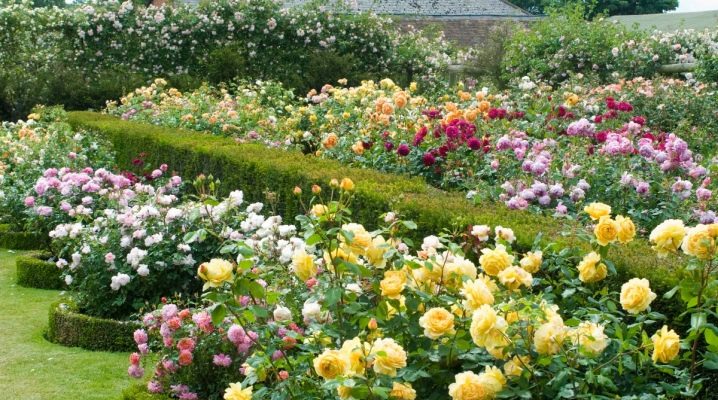
Roses are lovely royal flowers with a delicate scent. It is not surprising that their quivering beauty attracts millions of people. However, not all growers can acquire such specimens. These flowers are very sensitive to soil and care. Fortunately, in ornamental gardening, there are plants of equal appeal that look like roses.
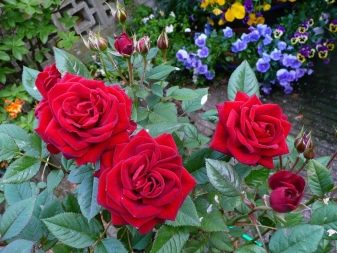
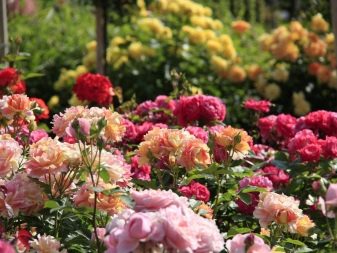
Terry adenium and its description
The houseplant of this species is also known as the desert rose. Terry adenium is very popular among flower lovers. Among its advantages are a long lifespan and fairly easy maintenance. In beauty they are not inferior to orchids, and in terms of cost, the plants are about the same.
Adeniums are used for single breeding and as bonsai trees.
The unusual plant has a thickened stem that branches well and has a dense caudex. Leaves are elongated with rounded or sharp tips in one of the following shades: from light green to dark green.
The buds are large and dense. Flowers that look like roses are enchanting. Red and white, pink and purple, up to 10 cm in diameter - they will not leave indifferent any grower. Several rows of petals make the flowers very lush. Flowering lasts up to 2 months.
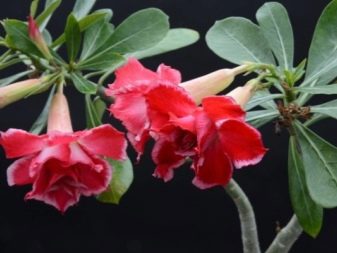

There are many types of terry adeniums, differing in height, size and shade of flowers. You can choose a plant that is suitable for a variety of tasks, from growing bonsai to the consciousness of your own mini-garden.
- Fire Fenghwang. It begins to bloom 1.5 years after germination. Has beautiful bright scarlet inflorescences.
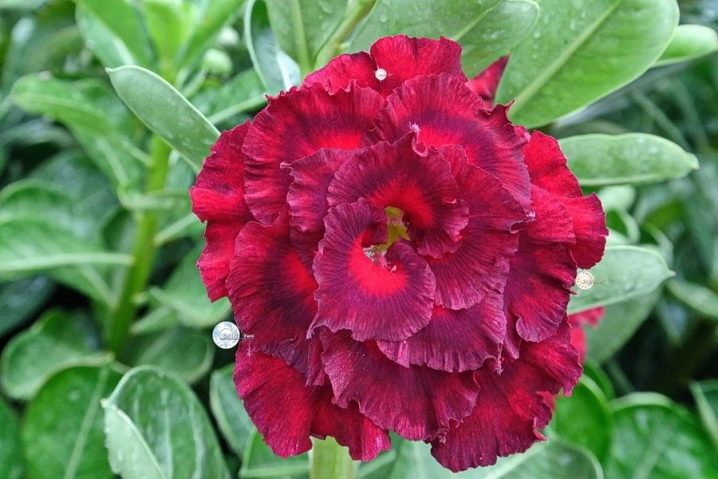
- White King. Dissolves large snow-white flowers.

- Monte Carlo. The center of the petals of this species has a pink tint, and the edges are lighter. The inflorescences are large.

- Flower Mermaid. With light pink flowers and wavy edging.
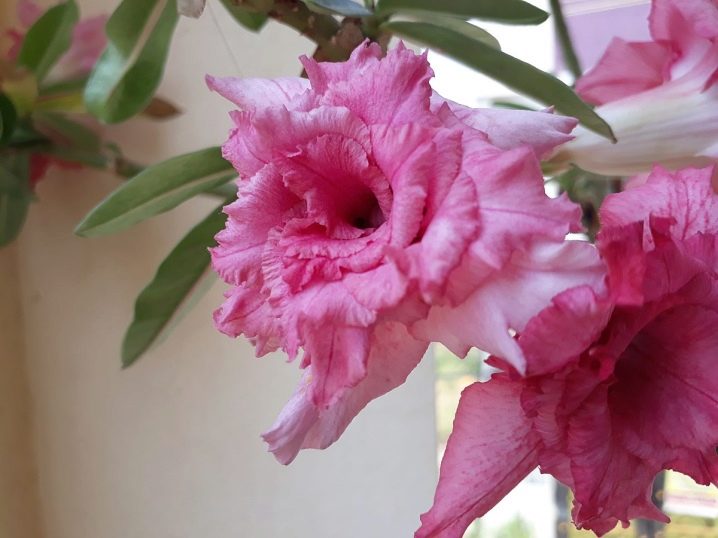
- Double Violet. It is characterized by a large number of purple flowers that appear earlier than other species and persist until late autumn.
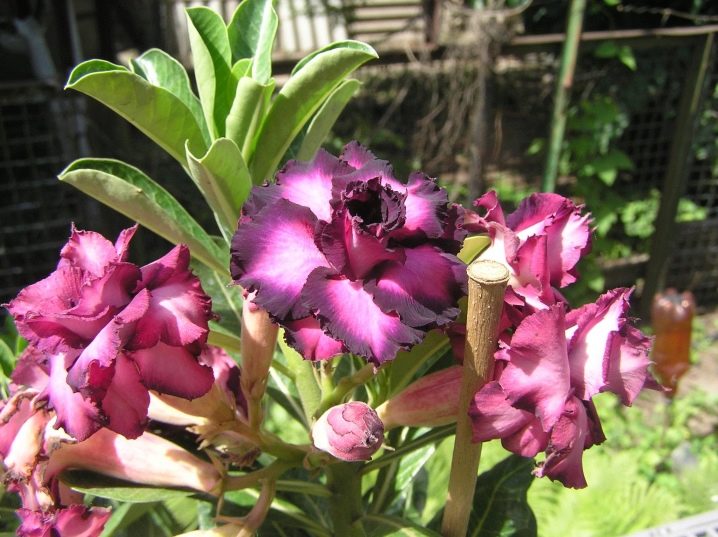
- Tender Feeling. It has white flowers with a wide pink border around the edge.
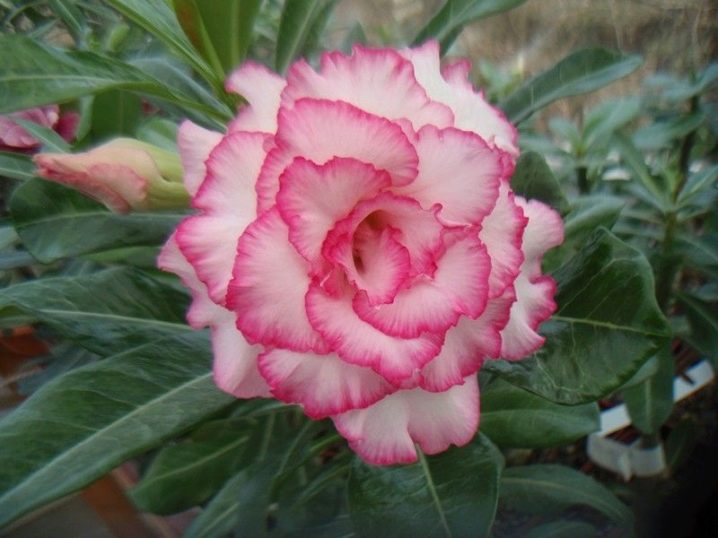
- Blissful Lullaby. The shape of the bloom is similar to the classic rose. The flowers have a creamy shade and a thin pink stripe.
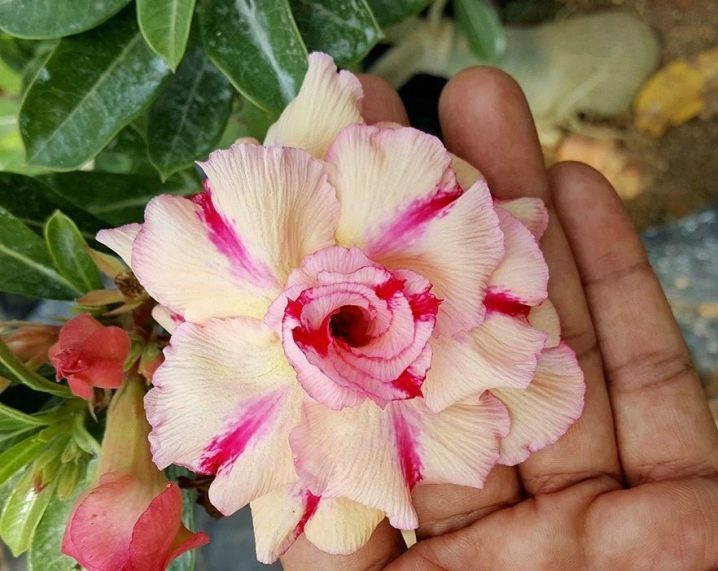
- Triple Santa Claus. Produces medium-sized flowers with bright red petals and white edging on them. An adult plant looks like a New Year's festive.
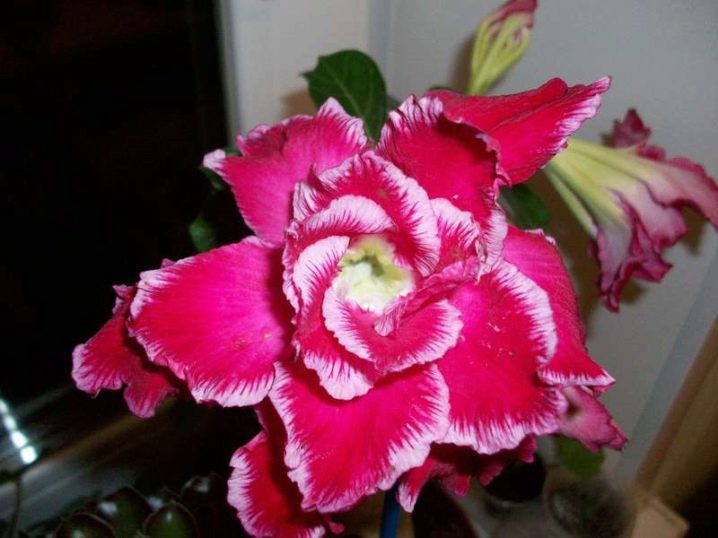
For flowering, adeniums need direct sunlight for at least 3 hours a day. Otherwise, the plants will only develop foliage.
When natural light is not enough, artificial sources can be used: halogen or fluorescent phytolamps.
Plants of this type require potash fertilizers. Top dressing is applied during the entire flowering period in moderation. A well-formed crown is also essential. The plant is pruned about once every 3 years. The more branches, the more magnificent the flowering will be.


The optimal pruning time is the beginning of spring, and it is advisable to cover the cuts. After the procedure, you must thoroughly wash your hands with soap and water. During the period of budding and flowering, terry adeniums are watered as the earthen coma dries.
When germinating seeds, the plant may lose or weaken some of its properties. However, terry adeniums with this breeding method can please with a delicate aroma.
When grown by splicing, a stalk of a developed varietal plant that emerged from a seed is taken. One way is to inoculate a growing kidney.

Begonia
Begonias are very diverse: tall and small, with a straight stem or none at all. There are many colors and they are very bright. The flowering period is during the summer season. The attractiveness of the plant will delight longer if you regularly use fertilizers with organic components.
About 800 species of begonias are known. The most popular cultures for home content are listed below.
- Tuberosa. It has flowers of white, yellow and red colors, they are up to 15 cm in size. There are two-color petals with a border.
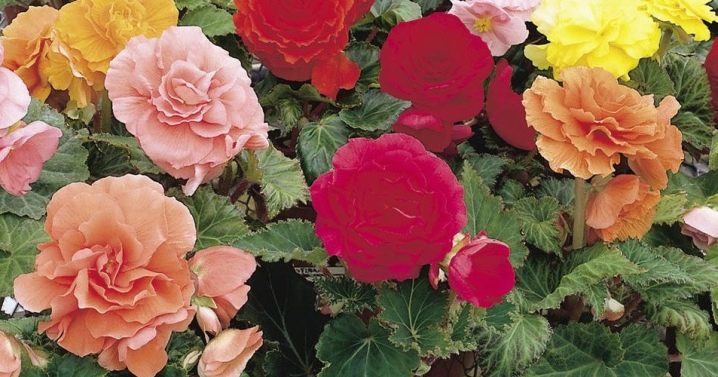
- Semperflorens. It has glossy leaves of red and green colors and small flowers of white and red shades.

- Begonia rex. Differs in large leaves (up to 30 cm) green, reddish or brown. The leaves are shaped like the heart or spiral of a snail.

- Coccinea. The plant has smooth ovoid leaves. Scarlet flowers grow like a panicle.
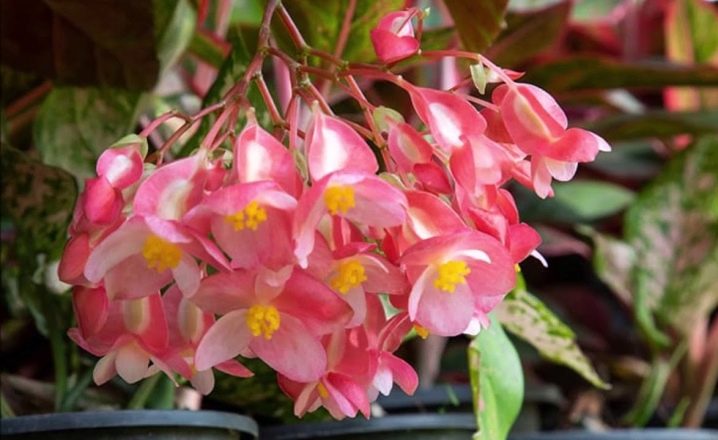
- Elatior. This species has thin red branches and round shiny leaves. The flowers are about 5 cm in size.

- Lorrain. A type of begonia with rounded leaves, waviness along the edge, up to 10 cm long.

A room with diffused light is suitable for begonias.
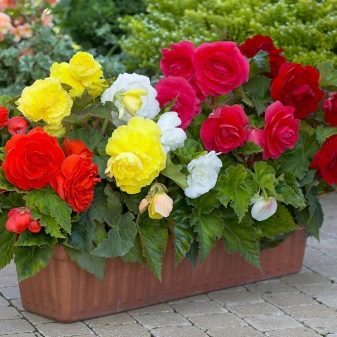

To maintain the attractive appearance of the plant, it is necessary to provide room temperature and high humidity. It is not recommended to spray it. In summer, begonia needs regular watering and good drainage. In winter, the amount of fluid is reduced. For wintering, tuberous species are placed in dry peat. Begonias are fed from the moment of flowering once a month.
Planting is carried out by planting seeds, dividing bushes, tubers and cuttings.
Seed shoots appear in about 2 weeks. The stalk is planted in moist soil in spring or summer and placed in a dark place. Begonia takes root after about 2 months.

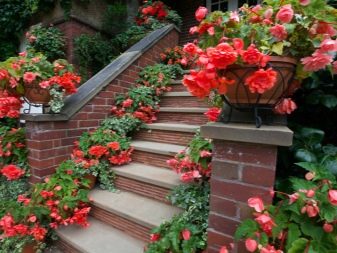
Gardenia
A small plant of the Madder family. The culture is shrubs, rarely trees, sometimes with thorns. Gardenias have a branched stem. Leaves are glossy, dark green shades. The flowers are white and yellow, located in the axils of the leaves and at the tips of the branches.
The gardenia genus includes more than 200 species. For home content, only one is common - Gardenia jasminoides.
It is a shrub that forms a lush bush up to 50 cm high. The jasmine gardenia has long, shiny leaves. Her flowers are single or in corymbose inflorescences, up to 7 cm in size, white in color, very similar to roses. They have a pleasant aroma. The plant blooms in summer and autumn.

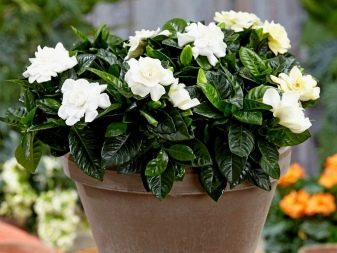
Gardenia is a rather demanding plant. The flower does not tolerate drafts, changes in the environment and location. Gardenias need sufficient light, but in the summer they should be protected from direct sunlight. The optimum temperature is maintained at 18–20 degrees.
When the gardenia is growing more vigorously, its leaves should be sprayed, avoiding water getting on the buds or flowers. In winter, watering is reduced to a minimum. It is better to use warm filtered or boiled water. When flowers appear, the plant should be fertilized every 2 weeks.
After the flowers have fallen off, half the length of the shoots is cut. Cuttings cut in February - March are used. Their length should be about 10 cm. They are rooted in warm (25-27 degrees) soil or water with the obligatory use of a phytostimulant. This is a rather long process. Rooted cuttings are pinched when they reach 15 cm in height.
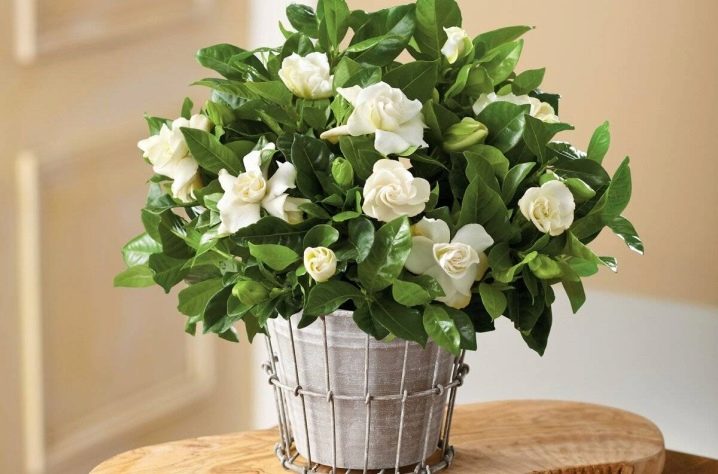
Other kinds of flowers
Not all flower lovers can afford a garden plot with conditions for growing roses. Red, yellow, pink - they have no equal in beauty, but, in addition to the above-described plants, there are others similar to these flowers, including their bush varieties. From a wide variety, you can choose a houseplant with or without thorns, with larger flowers or similar to small roses, annuals and perennials. A home balsam bush or purple terry primroses are great alternatives to the whimsical rose.
Hibiscus
The vast genus of plants includes up to 300 species. Hibiscus are trees, shrubs, or herbaceous plants. Their flowers are large, painted in bright various colors, except for black and blue. For home growing, there are several representatives.
This beautiful tree with flowers requires warmth, adequate ambient lighting and space. The optimum temperature is 16-22 degrees. Watering during growth and flowering hibiscus prefers abundant, in winter it shrinks. In spring and summer, you can use fertilizing with nitrogen-containing fertilizers once a month. It is best to prune branches in May and July.
Hibiscus is propagated using seeds and cuttings. Seeds are sown in January - March. Cuttings are cut in the spring-summer period with 2-3 internodes.


Terry balsam
It is a herbaceous shrub, reaching 30 cm at home. It has spreading stems, rounded-heart-shaped leaves and flowers that look like small roses.
In care, diffused lighting and room temperature are preferred. The irrigation regime depends on the season, dry air and the length of daylight hours. Moisten the soil as the top layer dries. The plant is fed in summer and spring with a frequency of up to twice a month. Regular pruning of the shrub crown is recommended. Terry balsam is propagated by seeds and cuttings.

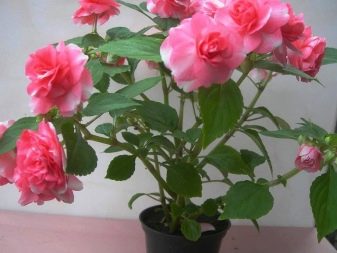
Hellebore
Perennial herb up to 50 cm high. Leaves are located near the ground and form a bush. The flowering period is February - April. Flowers or small inflorescences bloom at the tops of the stems. They are white, pink, yellow, dark blue, or purple.
The plant is unassuming to care for. The hellebore needs partial shade and moist soil.
The flower can be grown from seed or by dividing the bush.
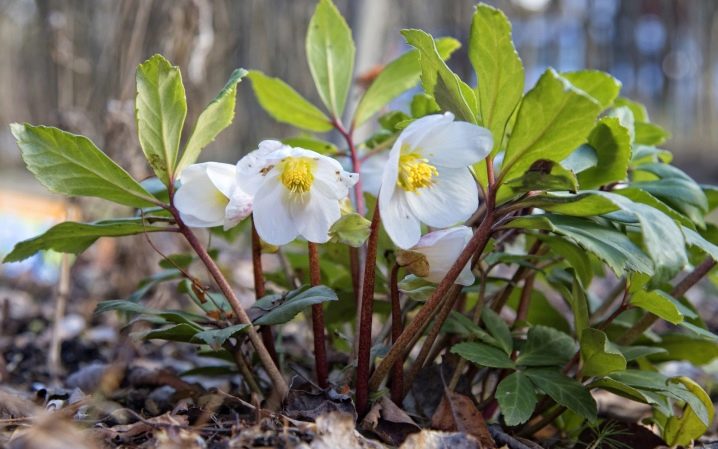
Terry primroses
Most of the species are perennial low herbaceous plants. The leaves are green and have slight wrinkles and hairs. The flowers are small, up to 2 cm in diameter, of various shades. Flowering occurs in May or June.
Plants prefer partial shade and moderate watering with good drainage.
Primroses are grown from seeds and by dividing the mother bush. Of the fertilizers, potash and phosphorus are used during active growth and flowering.
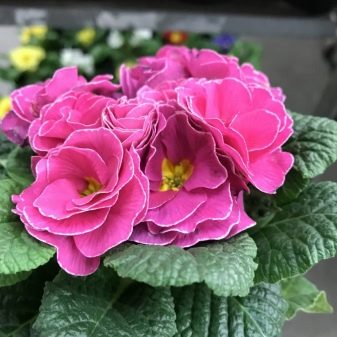
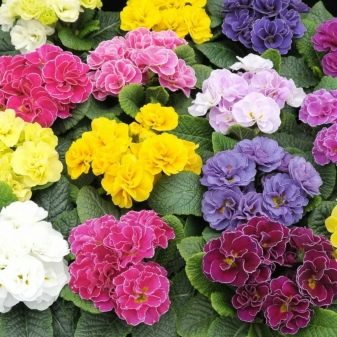
Ranunculus
Belongs to the Buttercup family. Ranunculus is a low plant, up to 30 cm tall. The leaves are decorative, emerald green, dense and densely pubescent. Ranunculus has flowers up to 10 cm in diameter.
There are species with one-color, two-color inflorescences, contrasting strokes along the edge.
The plant is quite unpretentious. He needs moderate watering with water at room temperature, a well-lit room without direct sunlight. Ranunculus need regular feeding with various fertilizers.
The plant is grown from tubers and seeds.

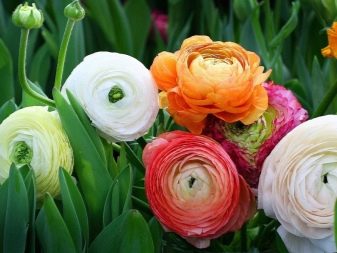
Adorable eustoma
The natural color of the flowers is purple and blue. Thanks to breeders, red, white, cream, pink and peach petals are found. Flowering occurs in spring. In addition, the flower has a pleasant, light scent. The plant is from 25 to 80 cm in size and above.
For good flowering, eustoma requires peat-sandy soil, an air temperature of about 20 degrees and watering sufficient to prevent the clod of earth from drying out. The soil should be light, moist and loosened.
The adorable eustoma is grown from seed and straight seedlings.
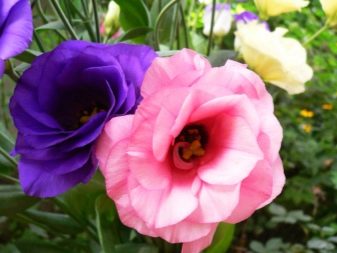
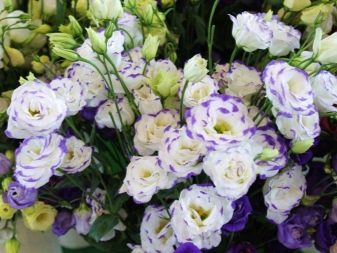







































































































The comment was sent successfully.